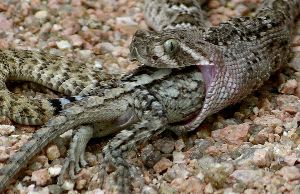
 Even some insects eat their meals so quickly that I hardly ever witness the event. One that comes to mind is the Praying Mantis. When these predators feast, they use their efficient chewing mouthparts to tear apart a hapless insect in seconds.
Even some insects eat their meals so quickly that I hardly ever witness the event. One that comes to mind is the Praying Mantis. When these predators feast, they use their efficient chewing mouthparts to tear apart a hapless insect in seconds.
On the other hand, there are some animals that linger over their meals, not out of pleasure or for the aesthetics of it, but because they are designed that way. Spiders might wrap up their prey quickly, but they then must inject digestive juices and finally suck the contents out of the victim. This takes time. I've seen a spider feeding on the same insect for hours. One house spider took most of the day to polish off a baby gecko it had caught in its web. Robber flies and predatory true bugs also feed slowly. Their mouthparts are such that they literally have to sip their meals through a straw. Hence, there is more time for an encounter where I can see them in the process.
One of the most interesting animals to watch at mealtime, though, is the snake. For a vertebrate, snakes take considerable time to swallow their food. Having no claws, paws or hands to help shovel it in is one reason. The most obvious thing, though, is that they don't chew their food and cannot gulp it either; they have to gradually slide what they are eating down into their digestive tracts.
Since snakes are slender, most of their prey is wider than they are. It reminds me of a cartoon by B. Kliban (famous for odd cat humor) with the caption "Never eat anything bigger than your head." Of course, this advice applies to humans and not snakes. The reptiles almost ALWAYS eat things bigger than their heads.
I usually find snakes consuming other cold-blooded creatures, rather than small mammals or birds. A hognose snake with a toad, a blotched water snake with a fish, and a ribbon snake with a tadpole are examples. The record for fast swallowing in the serpent world (at least in my experience) seems to be with grasshoppers. I've seen both a small checkered garter snake and a rough green snake grab and eat our biggest locusts. These grasshoppers have terribly spiky back legs, which they use to kick anyone who grabs them.  I can vouch for the fact that they do hurt. However, these snakes managed to grab the insect, manipulate it to go down head-first, and then swallow it, complete with spiny legs, in only a couple of minutes. I suspect that the relatively slender shape of the locusts makes the speedy ingestion possible.
I can vouch for the fact that they do hurt. However, these snakes managed to grab the insect, manipulate it to go down head-first, and then swallow it, complete with spiny legs, in only a couple of minutes. I suspect that the relatively slender shape of the locusts makes the speedy ingestion possible.
More often, though, snakes catch animals much larger. Even a tadpole, which is soft and slimy, seemed to present a real challenge to a tiny snake. Snakes have a marvelous adaptation for eating big things: their jaws are loosely hinged in several places. Unlike our jaws, which are fairly tightly attached to our skulls, a snake's bones are attached with stretchy ligaments. The two sides of the jaw also separate. Even the upper teeth are attached to moveable bones in the skull so that the snake can slide one side and then the other forward to grip just a little more each time.
This mechanism makes it almost seem realistic that a baby rattlesnake can swallow a big spiny lizard or a water snake can get a fat fish down its gullet. Still, the sight of a slender ribbon snake painstakingly edging its head over a frog simply looks completely improbable. Just one more of those entertaining moments that nature provides if we only take the time to look.